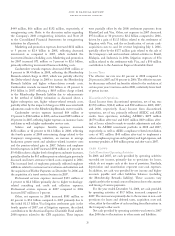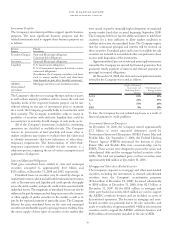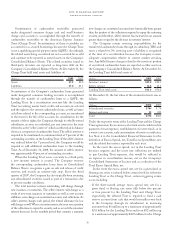American Express 2008 Annual Report Download - page 34
Download and view the complete annual report
Please find page 34 of the 2008 American Express annual report below. You can navigate through the pages in the report by either clicking on the pages listed below, or by using the keyword search tool below to find specific information within the annual report.
2008 financial review
american express company
reestablish loss reserves of approximately $1.8 billion, which
would reduce the Company’s regulatory capital ratios at the bank
holding company level. The consolidation of the Lending Trust
would primarily impact the Company’s Centurion Bank and
FSB bank subsidiaries. Any consolidation of the Lending Trust
could increase Centurion Bank’s and FSB’s risk-weighted assets
as well as the required capital on their respective balance sheets
to satisfy regulatory capital requirements.
consolidated capital
resources and liquidity
The Company’s balance sheet management objectives are to
maintain:
• A solid and flexible equity capital profile;
• A broad, deep and diverse set of funding sources to finance
its assets and meet operating requirements; and
• Liquidity programs that enable the Company to meet its
obligations for at least a 12 month period should some or all
of its funding sources become inaccessible.
capital strategy
The Company’s objective is to retain sufficient levels of capital
generated through earnings and other sources to maintain
a solid equity capital base and to provide flexibility to satisfy
future business growth. The Company believes capital allocated
to growing businesses with a return on risk-adjusted equity in
excess of its costs will generate shareholder value.
The level and composition of the Company’s equity
capital are determined in large part by the Company’s internal
assessment of its portfolios, consolidated rating agency and
regulatory capital requirements, and are also influenced by
subsidiary capital requirements for the consolidated entity, the
business environment, and by conditions in the debt funding
markets. The Company, as a bank holding company, is subject
to regulatory requirements administered by the U.S. federal
banking agencies. The Federal Reserve Board has established
specific capital adequacy guidelines that involve quantitative
measures of assets, liabilities, and certain off-balance sheet
items. The Company was not subject to these guidelines prior
to becoming a bank holding company. In addition, Centurion
Bank and FSB are subject to regulatory capital requirements
of the Federal Deposit Insurance Corporation (FDIC) and
the Office of Thrift Supervision, respectively.
The following table presents the risk-based capital ratios
and leverage ratio for the Company and its significant banking
subsidiaries at December 31, 2008:
Well-
Capitalized
Ratio
2008
Actual
Risk-Based Capital
Tier 1 6.0%
American Express Company 9.7%
Centurion Bank 12.3%
FSB(a) 12.7%
Total 10.0%
American Express Company 11.1%
Centurion Bank 13.7%
FSB(a) 14.0%
Tier 1 Leverage 5.0%
American Express Company 8.5%
Centurion Bank 13.2%
FSB(a) 12.2%
(a) Subsequent to December 31, 2008, the Company infused $500 million of
additional capital into FSB.
The Company was not previously required to calculate
risk-based capital ratios or a leverage ratio. The methodology
of calculating these ratios may be refined over time.
The Company’s Tier 1 Risk-based, Total Risk-based, and
Tier 1 Leverage ratios would have been approximately 13.1
percent, 14.6 percent and 11.5 percent, respectively, had the
$3.39 billion of proceeds from the U.S. Department of Treasury
Capital Purchase Program (CPP) as discussed below, been
received on December 31, 2008.
At December 31, 2008, the Company’s ratio of common
shareholders’ equity and tangible common shareholders’ equity to
risk-weighted assets was 11.3 percent and 8.5 percent, respectively.
Common shareholders’ equity equals the Company’s shareholders’
equity of $11.8 billion at December 31, 2008 and tangible common
shareholders’ equity equals common shareholders’ equity less
goodwill and intangibles of $3.0 billion. The Company believes
that presenting the ratio of tangible common shareholders’ equity
to risk-weighted assets is a useful measure of evaluating the
strength of the Company’s capital position.
The Company seeks to maintain capital levels and ratios
in excess of the minimum regulatory requirements; failure to
maintain minimum capital levels could cause the respective
regulatory agencies to take actions that could limit the
Company’s business operations.
The Company’s primary source of equity capital has been
through the generation of net income. Historically, capital
generated through net income and other sources such as
employee benefit plans has exceeded the growth in its capital
requirements. To the extent capital has exceeded business,
regulatory, and rating agency requirements, the Company
32
























